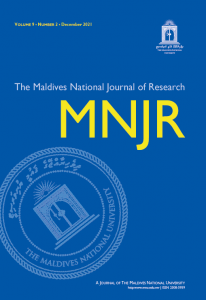Lived experience of subject matter experts in the instructional design process for blended learning at The Maldives National University: a phenomenological study
DOI:
https://doi.org/10.62338/wfn0p667Keywords:
Instructional design, phenomenological, blended learning, teaching and learningAbstract
Blended learning requires the detailed combination of both in-person and online learning activities. To achieve the best result of improved learning outcomes, the conversion of a face-to-face course for blended learning delivery should follow a systematic process of instructional designing. The process involves collaboration between instructional designers (IDs), who are well-trained in adult pedagogical methods, and faculty Subject Matter Experts (SMEs), who provide expertise on the content to be delivered through the blended course. As a review measure on the instructional design process at the Maldives National University (MNU), this study explored the experiences of SMEs as they interact with instructional designers to design and develop blended learning courses. Ten SMEs who collaborated with instructional designers in the instructional design process for different subjects for the past four years were interviewed to share their experience. The thematic analysis of the results depicted that the instructional designing process improved their pedagogical approach and delivery with increased student satisfaction and made the teaching and learning process easier and effective. Along with it many agreed that the academic workload is a major challenge. The study implies instructional design process as a requirement for the best result of improved learning outcomes in blended learning. The process allows the implementation of blended course structures and pedagogical choices for interaction, material distribution, learning facilitation, direct instruction and constructed organisation and design throughout the course with dedicated student participation and critical reflections for both in-person and online learning. Hence, the process should be continued and solutions should be sought to overcome the challenges for the successful implementation.
References
Aldoobie, N. (2015). ADDIE Model. American International Journal of Contemporary Research, 5(6), 68-72.
Ali, L. (2018). The design of curriculum, assessment and evaluation in higher education with constructive alignment. Journal of Education and e-Learning Research, 5(1), 72-78.
Anderson, M. C., Love, L. M., & Hagga, F. L. (2019). Looking beyond the physician educator: The evolving roles of instructional designers in medical education. Medical Science Educator, 507-513.
Andrew, C. W., Lennon, L., & Weber, N. L. (2021). Student perceptions of online active learning practices and online learning climate predict online course engagement. Interactive Learning Environments, 29(5), 866-880.
Arnold, D., Edwards, M., Magruder, O., & Moore, S. (2018). The competencies and goals of instructional designers: A survey study. UPCEA eDesign Collaborative,1-19.Instructional design process for blended learning.
Bennett, L., & Albrecht, A. (2014, November 10). Analyzing the Instructional Designer Role: A New Framework to Improve Efficacy and Dynamic Partnerships.Retrieved 2022, from The Free Library: https://www.thefreelibrary.com/
Braun, V., & Clarke, V. (2006). Using thematic analysis in psychology. Qualitative Research in Psychology, 3(2), 77-101.
Cleveland-Innes, M., & Wilton, D. (2018). Guide to blended learning. Canada: Commonwealth of Learning.
Frechette, J., Bitzas, V., Aubry, M., Kilpatrick, K., & Lavoie-Tremblay, M. (2020). Capturing lived experience: Methodological considerations for interpretive phenomenological inquiry. International Journal of Qualitative Methods, 19, 1-12.
Frederick, C. B. (2021). Lived experiences of instructional designers who designed online information technology courses with hands-on activities. Walden Dissertations and Doctoral Studies.
Hart, J. (2018). Instructional designer’s experiences with faculty subject matter experts in online higher education course development projects (PhD Thesis). Capella University.
Hashim, A. (2014). COL: Form a Historical Perspective. COL: 15 year Service Magazine Special issue, Centre for Open Learning, 20-29
Jnanathapaswi, S. G. (2021). An introduction to social science research. New Delhi: APH Publishing Corporation.
Kumar, S., & Ritzhaupt, A. (2017). What do instructional designers in higher education really do? International Journal on E-Learning, 16(4), 371-393.
Mancilla, R., & Frey, B. (2020). A model for developing instructional design professionals for higher education through apprenticeship: Blending theory and practice. The Journal of Applied Instructional Design, 9(2), 1-8.
Martin, F., & Ritzhaupt, A. D. (2020). Standards and competencies for instructional design and technology professionals. In J. K. McDonald, & R. E. West, Design for learning: Principles, processes, and praxis. EdTech Books.
McGee, P., & Reis, A. (2012). Blended course design: a synthesis of best practices. Journal of Asynchronous Learning Networks, 16(4).
MNU. (2019). Annual Report. Male City: MNU. Retrieved April 7, 2023, from chrome-extension://efaidnbmnnnibpcajpcglclefindmkaj/http://mnu.edu.mv/wp-content/uploads/2022/02/Annual-Report-2019.pdf
Moustakas, C. (1994). Phenomenological research methods. London: SAGE Publications.
Mutlu, G. (2016). A qualitative analysis and comparison of the two contemporary models of instructional design. Journal of Human Sciences, 6154-6163.
Nworie, J. (2022). The increasing quest for instructional designers and Technologists in higher education and corporate settings. Contemporary Educational Technology, 1-20.
Partis, M. (2003). Hope in homeless people: a phenomenological study. Primary Health Care Research and Development, 9-19.
Sims, R. C., & Koszalka, T. (2008). Competencies for the new-age instructional designer(3 ed.). New York: Lawrence Erlbaum Associate Publishers.
Susiana, W. E. (2019). Using the ADDIE model to develop learning material for actuarial mathematics. Journal of Physics: Conf. Series, 1-8.
Xu, Z., & Shi, Y. (2018). Application of constructivist theory in flipped classroom — Take college Englisht eaching as a case study. Theory and Practice in Language Studies, 8(7), 880-887



